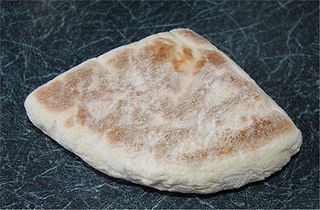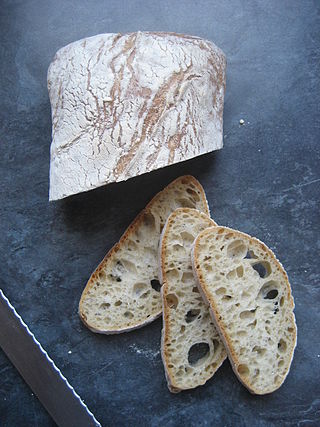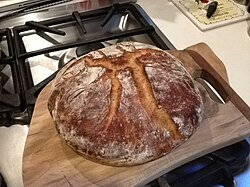
Bread is a staple food prepared from a dough of flour and water, usually by baking. Throughout recorded history and around the world, it has been an important part of many cultures' diet. It is one of the oldest human-made foods, having been of significance since the dawn of agriculture, and plays an essential role in both religious rituals and secular culture.

Pastry is baked food made with a dough of flour, water, and shortening that may be savoury or sweetened. Sweetened pastries are often described as bakers' confectionery. The word "pastries" suggests many kinds of baked products made from ingredients such as flour, sugar, milk, butter, shortening, baking powder, and eggs. Small tarts and other sweet baked products are called pastries as a synecdoche. Common pastry dishes include pies, tarts, quiches, croissants, and pasties.

Sourdough or sourdough bread is a bread made by the fermentation of dough using wild lactobacillaceae and yeast. Lactic acid from fermentation imparts a sour taste and improves keeping qualities.
In cooking, a leavening agent or raising agent, also called a leaven or leavener, is any one of a number of substances used in doughs and batters that cause a foaming action that lightens and softens the mixture. An alternative or supplement to leavening agents is mechanical action by which air is incorporated. Leavening agents can be biological or synthetic chemical compounds. The gas produced is often carbon dioxide, or occasionally hydrogen.

Dough is a thick, malleable, sometimes elastic paste made from grains or from leguminous or chestnut crops. Dough is typically made by mixing flour with a small amount of water or other liquid and sometimes includes yeast or other leavening agents, as well as ingredients such as fats or flavorings.

Soda bread is a variety of quick bread made in many cuisines in which sodium bicarbonate is used as a leavening agent instead of yeast. The basic ingredients of soda bread are flour, baking soda, salt, and buttermilk. The buttermilk contains lactic acid, which reacts with the baking soda to form bubbles of carbon dioxide. Other ingredients can be added, such as butter, egg, raisins, or nuts. Quick breads can be prepared quickly and reliably, without requiring the time and labor needed for kneaded yeast breads.

A bread making machine or breadmaker is a home appliance for baking bread. It consists of a bread pan, at the bottom of which are one or more built-in paddles, mounted in the center of a small special-purpose oven. The machine is usually controlled by a built-in computer using settings input via a control panel. Most bread machines have different cycles for different kinds of dough—including white bread, whole grain, European-style, and dough-only. Many also have a timer to allow the bread machine to function without operator input, and some high-end models allow the user to program a custom cycle.

Ciabatta is an Italian white bread made from wheat flour, water, salt, yeast and olive oil, created in 1982 by a baker in Adria, province of Rovigo, Veneto, in response to the popularity of French baguettes. Ciabatta is somewhat elongated, broad, and flat, and is baked in many variations, although unique for its alveolar holes. Ciabatta is made with a strong flour and uses a very high hydration dough.

In cooking, kneading is a process in the making of bread or dough, used to mix the ingredients and add strength to the final product. It allows the process of baking to be shortened by developing the gluten more quickly than it would develop in the absence of kneading.

A ferment is a fermentation starter used in indirect methods of bread making. It may also be called mother dough.
The Chorleywood bread process (CBP) is a method of efficient dough production to make yeasted bread quickly, producing a soft, fluffy loaf. Compared to traditional bread-making processes, CBP uses more yeast, added fats, chemicals, and high-speed mixing to allow the dough to be made with lower-protein wheat, and produces bread in a shorter time. It was developed by Bill Collins, George Elton and Norman Chamberlain of the British Baking Industries Research Association at Chorleywood in 1961. As of 2009, 80% of bread made in the United Kingdom used the process.

Beer bread is any bread that includes beer in the dough mixture. Depending on the type of beer used, it may or may not contribute leavening to the baking process. Thus, beer breads range from heavy, unleavened, loaves to light breads and rolls incorporating baker's yeast. The flavor of beer bread is sometimes enhanced with other flavors, such as cheese or herbs.

In cooking, proofing is a step in the preparation of yeast bread and other baked goods in which the dough is allowed to rest and rise a final time before baking. During this rest period, yeast ferments the dough and produces gases, thereby leavening the dough.

Vienna bread is a type of bread that is produced from a process developed in Vienna, Austria, in the 19th century. The Vienna process used high milling of Hungarian grain, and cereal press-yeast for leavening.
The sponge and dough method is a two-step bread making process: in the first step a sponge is made and allowed to ferment for a period of time, and in the second step the sponge is added to the final dough's ingredients, creating the total formula. In this usage, synonyms for sponge are yeast starter or yeast pre-ferment. In French baking the sponge and dough method is known as levain-levure. The method is reminiscent of the sourdough or levain methods; however, the sponge is made from all fresh ingredients prior to being used in the final dough.

Basler Brot, in Basel also Basler Laibli, is a bread traditionally made in the Swiss cantons of Basel-Stadt and Basel-Landschaft, but now popular in all of Switzerland. It is distinguished from other Swiss breads by a very soft, porous dough and a mealy, crunchy crust.
A Grant loaf is a wholemeal bread, invented by accident in World War II by baker Doris Grant to encourage workers to eat well on their rations. The loaf was subsequently named after her. It is peculiar amongst breads made with a yeast in that kneading is not necessary.

Straight dough is a single-mix process of making bread. The dough is made from all fresh ingredients, and they are all placed together and combined in one kneading or mixing session. After mixing, a bulk fermentation rest of about 1 hour or longer occurs before division. It is also called the direct dough method.
Peter Reinhart is an American baker, educator and author. He is most known for writing Bread Revolution, American Pie: My Search for the Perfect Pizza, The Joy of Gluten-Free, Sugar-Free Baking and The Bread Baker’s Apprentice. Four of his books have been nominated for James Beard Awards, with three of them winning, including the "Book of the Year" in 2002 for The Bread Baker's Apprentice.














